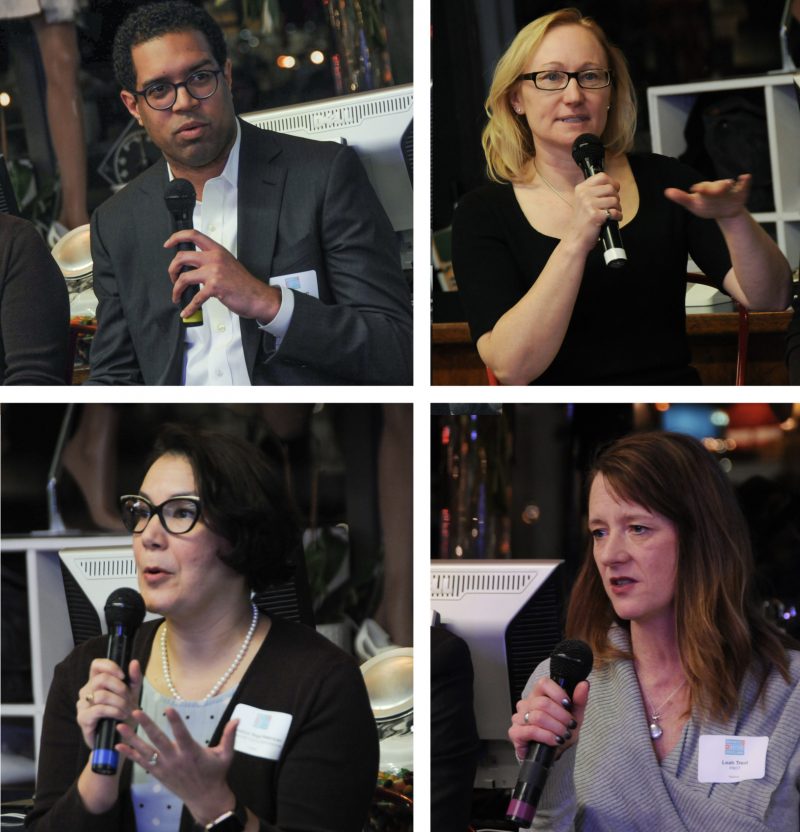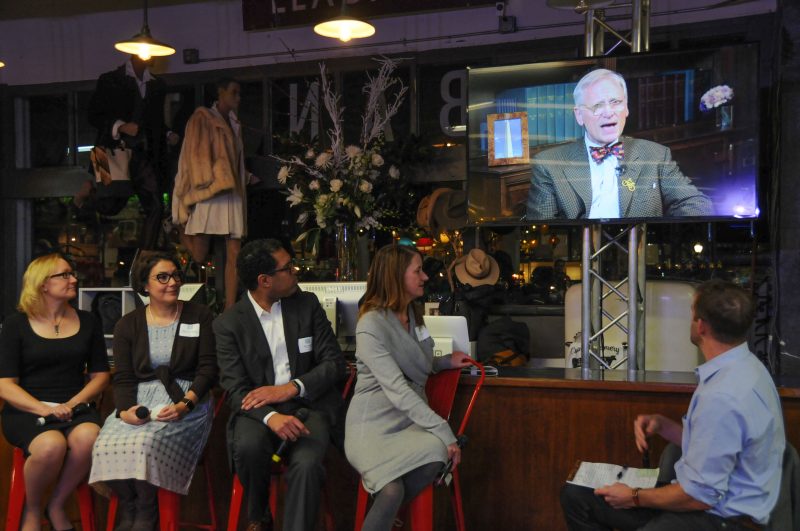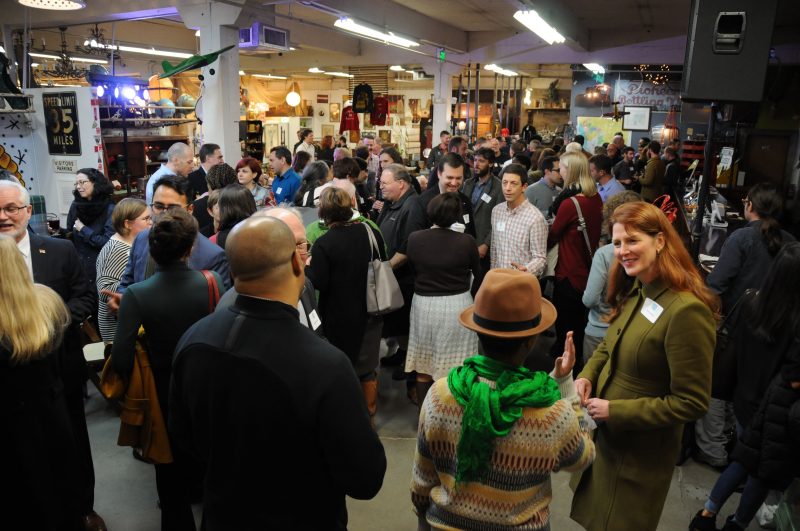
(Photos: J. Maus/BikePortland)
Business for a Better Portland hosted its first policy event of the year last night. The up-and-coming association is looking to be a counterbalance the impact of the Portland Business Alliance, a more conservative group that has had a vast — and some would say deleterious — influence on city transportation policy over the years.
“When I got here the PBA [Portland Business Alliance] was the only voice that was listened to. In four short years that has changed dramatically and this business group has tremendous influence.”
— Leah Treat, PBOT
Billed as “Portland’s Transportation Future: Business Stepping Up To The Challenge” — the goal of the event was primarily one of education and networking. If Portland is going to fulfill a progressive transportation agenda that breaks through the driving-dominant status quo that’s shackling us to the past, the business leaders of our region must rally behind a new vision and lobby electeds and bureaucrats to make it a reality. Business for a Better Portland seems poised to lead that movement, having grown from zero to 210 dues-paying members in the past year alone.
One of the panelists, Portland Bureau of Transportation Director Leah Treat, spoke to this dynamic during last night’s discussion. “This organization has had a growing voice in the city, especially with City Hall,” she shared. “When I got here the PBA [Portland Business Alliance] was the only voice that was listened to. In four short years that has changed dramatically and this business group has tremendous influence.”
The event featured Treat and three other transportation leaders: Multnomah County Commissioner Jessica Vega Pederson; former Washington Secretary of Transportation (and candidate for Metro President) Lynn Peterson; and Nolan Lienhart, the director of planning and urban design at ZGF Architects. The moderator was Oregon Humanities Director Adam Davis.


It seems like no discussion of Portland’s transportation future can happen without a look back at the projects and people who were present during our glory days. Last night it was U.S. Congressman Earl Blumenauer who set the table with a pre-recorded video message (he was busy at a State of the Union-related event). From a big screen above the panelists and crowd, Blumenauer said the Portland region needs to figure out its priorities and move forward on them. “This is an outgrowth of deep expressions of concern I’ve heard from our community over the last few years,” he said, “That our region is falling behind on transportation and infrastructure.”
“This is an outgrowth of deep expressions of concern I’ve heard from our community over the last few years that our region is falling behind on transportation and infrastructure.”
— Earl Blumenauer, congressman
We’ve been pounding this stagnation problem for many years now and believe me when I say this: It is no small thing for one of the most prominent figures in Portland’s lauded transportation legacy to publicly acknowledge that Portland has fallen behind. (Leaders rely on the success narrative to cement their legacy and positions, so admitting things have gotten bad takes courage and integrity.)
“Our past successes,” Blumenauer continued (after mentioning light rail, defeating the Mt. Hood Freeway, and the Tilikum Crossing), “are not the end of our story.”
The problem as Blumenauer sees it — and what became a recurring theme of the evening — is that leaders in our region can’t agree on a vision to move forward with. “Our region is struggling to fully agree on what we should do next and exactly what we need… We appear frozen in place.”
The moderator Adam Davis then asked the panelists several questions. There wasn’t any huge news made here and since the event wasn’t intended to be wonky, no one got into the weeds on anything. But there were some notable statements and exchanges.
When asked by the moderator to name existing obstacles that prevent us from moving forward, PBOT Director Treat made a passionate plea for more citizen advocacy:
“At the City of Portland, we have so many amazing projects lined up. So many things that we can deliver. We have tons of stuff we want to do. What we need is support from the business community, from Portlanders everywhere, to help our council make some really hard decisions. Every time that we do a big transportation project, the sense at city council is that there are binary choices being made; that there are winners and losers being presented. And rather than having a conversation about who’s winning and losing, we need people to come together and voice their support for outcomes and policy decisions that the council needs to stick with. Every Wednesday morning at 9:00 the council agenda is open for anyone to come talk about anything. And they listen. If you showed up in front of council your voice will be 100 times more important than mine over the course of the year. So show up!”
Advertisement

Jessica Vega Pederson said the problem is that a clear vision has not been articulated. Lynn Peterson said we focus too much on individual projects and we need to, “Go toward a corridor mentality.” Nolan Lienhart said, “We’ve done a lot of the big visionary things people were thinking about us needing to do in the 70s and early 80s — so now it’s time to recharge that.”
“Our vision needs to be a description of a system rather than a disparate strategy. Yes it’s not the same solution everywhere, but it’s also not six different solutions that don’t relate to each other.”
— Nolan Lienhart, ZGF
When the discussion turned to the geographic equity — and inequity — of transportation investments, Lienhart said our planning approach should be more unified. “Our vision needs to be a description of a system rather than a disparate strategy. Yes it’s not the same solution everywhere, but it’s also not six different solutions that don’t relate to each other.”
Then there was an interesting exchange between Peterson and Treat. Peterson argued for having a, “Base level of service we are providing for everyone in the region.” To which Treat replied, “I agree… But people in east Portland have been under-invested and under-serviced, and they still have the worst transportation network in the city. So while we do want to have an overall system that works for everyone, I think it’s disingenuous to not point out that we have much greater need and obligation to invest in east Portland.”
The highlight of the night was an audience question.
The panelists were seated in front of north-facing windows that looked onto rush-hour on the SE Grand-Martin Luther King Jr. Blvd couplet. A man in the back of the room (I regret not getting his name) said, “The backdrop behind you is an unending stream of cars coming off the Morrison Bridge. It’s deliciously ironic. This [pointing to the room] is the choir, that [pointing outside] is the congregation. What do you preach to them when they think that whatever you say is going to cost them more and leave them with less?”
Treat, who was very sharp all night, jumped on it. Here’s her answer:
“We are experiencing tremendous population growth, and they’re going to continue to come. Our system is reaching capacity and the way we have to manage it is not going to be through building new roads, so we have to start working the system to help prioritize throughput for cars, to help prioritize throughput for freight, and add travel options for other people. And I don’t know if we’ll be able to say, ‘It won’t cost you more.’ We’re looking at congestion/value pricing for a reason. The studies we have from the Rose Quarter show that 26 percent of the trips that are made at the PM peak through the Rose Quarter are discretionary. If we can get 26 percent of discretionary trips off the Rose Quarter in the PM peak, it would be the same effect as building the auxiliary lanes as proposed [In the I-5 Rose Quarter project]. So we can’t please everybody and we’re all competing for very valuable space.”
Treat’s comment is important. Note that her argument includes telling people who mostly drive that their trip times might actually improve if we redesigned roads and started to charge people to use them. And the best line of the night was how she directly questioned the need for the new lanes as proposed by the Oregon Department of Transportation in the I-5 Rose Quarter project. PBOT has been a staunch ally and partner of ODOT’s on that controversial freeway widening project. Are Treat’s comments a sign that the City of Portland might support pricing and transportation demand management before the project breaks ground?. CORRECTION, 2/1: Portland City Council passed an amendment to the Comp Plan in October stating that ODOT and PBOT should work together to use pricing and TDM, “as soon as feasible and prior to the opening of this project.”
Overall, the night felt like a sucess for Business for Better Portland. From a policy standpoint, there was a lot of talk about a vision but there was still no clear description of what it should be. Another thing I’ll takeaway is that it is now completely mainstream to acknowledge — even at the highest levels of leadership — that Portland has fallen behind and is in dire need of a bold wake-up call that can summon the courage we had 40 years ago.
From here, Business for a Better Portland says they’ll convene a working-group to come up with a transportation-related “call to action” they’ll broadcast in March. Stay tuned.
— Jonathan Maus: (503) 706-8804, @jonathan_maus on Twitter and jonathan@bikeportland.org
Never miss a story. Sign-up for the daily BP Headlines email.
BikePortland needs your support.

